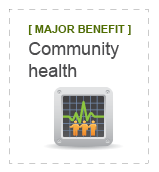Create a network of green complete streets that improves city quality of life, public health, and adds value to surrounding properties.
Nissa Tupper, Transportation and Public Health Planning Director, Office of Sustainability and Public Health, MN Dept. of Transportation: 651/366-4807, Nissa.Tupper@state.mn.us, www.dot.state.mn.us/complete-streets


Complete Streets in Minnesota offer many benefits, including improved safety, advancing transportation equity, strengthening local economies, and building healthy, climate-resilient communities. The Minnesota Department of Transportation (MnDOT) has more information about benefits, community case studies, research, and guidance at the MnDOT Complete Streets website.
- Equitable Communities: Providing affordable, accessible, and safe options for walking, biking, and transit can improve equitable outcomes. Dependence on driving a car can be a significant burden for lower-income communities. Car ownership is expensive, costing roughly $1,000 per month, and should not be a requirement for getting around safely and efficiently. In the Twin Cities, a household with a median income spends 48.9% of its income on transportation and housing, compared to 75.3% for a low-income household. This reduces available funds for expenses like childcare, health care, and recreation.
- Healthy Communities: 75% of Americans do not get the CDC’s recommended amount of physical activity. This physical inactivity contributes to 1 in 10 premature deaths and an estimated $117 billion in annual health care costs (Center for Disease Control and Prevention, 2024).
- Healthy Communities: A 2010 Metropolitan Council analysis of the effects of land planning and urban design on travel demand documented that changes in vehicle miles traveled are most strongly related to (1) accessibility to destinations, especially jobs, and (2) street network design variables. Those variables - street connectivity and intersection density - correlate with improved public health outcomes. These variables are the key attributes of the old-fashioned grided networks that allow multiple ways to travel from A to B. Recent research shows that hierarchical street systems are less resilient to disruption and have less capacity than the grided network of streets. Arterials and collectors are also especially hostile to non-automotive modes of travel such as bikes and pedestrians.
- Healthy and Safe Communities: Reallocating roadway space to better meet the needs of people walking, biking, rolling, and taking transit has demonstrated benefits for many Minnesota communities. Case studies are available at the MnDOT web site.
- Healthy and Safe Communities: Modest street and lane reconfigurations can have major impact on traffic calming and public safety. A recent study by Johns Hopkins School of Public Health revealed narrowing street widths by two to three feet resulted in 1.5 times less crashes due to lower speeds. Additionally, the narrower roads promoted more active transportation infrastructure such as sidewalks and bike paths (Johns Hopkins, 2024).
- Healthy and Climate-Resilient Communities: Connected street networks, on a grid or modified grid pattern help disperse rather than concentrate traffic. This provides an opportunity to reduce congestion and reduce greenhouse gas pollution from transportation idling.
- Safe and Climate-Resilient Communities: The energy savings from no signals and no/little idling at roundabouts, compared to signalized intersections, has been estimated to be about 9% (averaging $84,000/yr.). The introduction of roundabouts as a proven safety countermeasure also provide safety and benefits. A 2017 MnDOT study documented a reduction of as much as 90% in fatal or incapacity injuries, a 75% decrease in injury-producing crashes, and a 39% decrease in all types of auto crashes. Roundabouts also slow traffic, reducing the need for police patrols, are less expensive to build than signalized intersections (by roughly $150,00), and increase hourly traffic flow in excess of 65%.
- Strong Local Economies: A large body of literature has found evidence that residential and commercial property values benefit from transit access and walkability improvements. MnDOT completed a recent study specific to Minnesota cities in 2022 with a compendium of case studies.
- Strong Local Economies: Albert Lea, Minnesota added nine miles of new sidewalks and three miles of bike lanes to their downtown in 2009 and have seen more than a dozen new businesses relocate to their downtown, more than $2.5 million invested in downtown since the project wrapped, and a 25% increase in property values on main street.
- Minnesota Statutes § 174.75 requires MnDOT to implement a Complete Streets policy that addresses “relevant protocols, guidance, standards, requirements, and training, and shall integrate related principles of context-sensitive solutions”.
- Minnesota Statutes § 174.01 identifies transportation system goals that include minimizing fatalities and injuries for transportation users throughout the state and providing multimodal facilities and services to increase access for all persons and businesses.
- The Statewide Health Improvement Program (SHIP) distributes funding to Community Health Boards and tribal governments across Minnesota to increase active transportation by means of, among other actions, adopting a complete streets policy.
- MnDOT Complete Streets Handbook offers guidance for agency staff and partners on how to implement and comply with requirements of the MnDOT Complete Streets policy.
Step 3 Recognition Best Practice for Category A cities
Category A cities: implement this best practice by completing action 1 and two additional actions.
Category B cities: implement this best practice by completing action 1 and one additional action.
Category C cities: implement this best practice by completing action 1.
Cities have a unique feature that set them apart from rural areas and many suburbs: people in cities live and work close to many others. Despite the rise of electronic networking, cities still thrive on the daily physical interactions between diverse groups of people with complementary skills and abilities.
Think of a street as a context-sensitive platform or engine for wealth creation. It acts as an outdoor room that adds value to surrounding properties by providing safe and pleasant access. The Complete Streets approach is flexible and valuable across different community types, from rural to suburban to metropolitan areas. Its benefits include improved safety, stronger community connections, increased access to active transportation options, and environmental and economic gains.
A well-designed, aesthetically pleasing street network serves people when they’re driving, riding, walking, rolling, and taking public transportation. What a Complete Street looks and feels like will differ depending on the individual community’s needs and should be defined through close collaboration with local partners and community members. Common threads for a successful Complete Streets approach are to focus on improving safety for the most vulnerable road users, increase mobility and access for all, and design in a way that’s responsive to local context.
While road restriping and mill-and-overlay projects afford more frequent opportunities to make system improvements, make sure to plan for the once-in-50-years road reconstruction opportunity to make significant road improvements.
Metric # 4: Infrastructure for Biking and Walking
